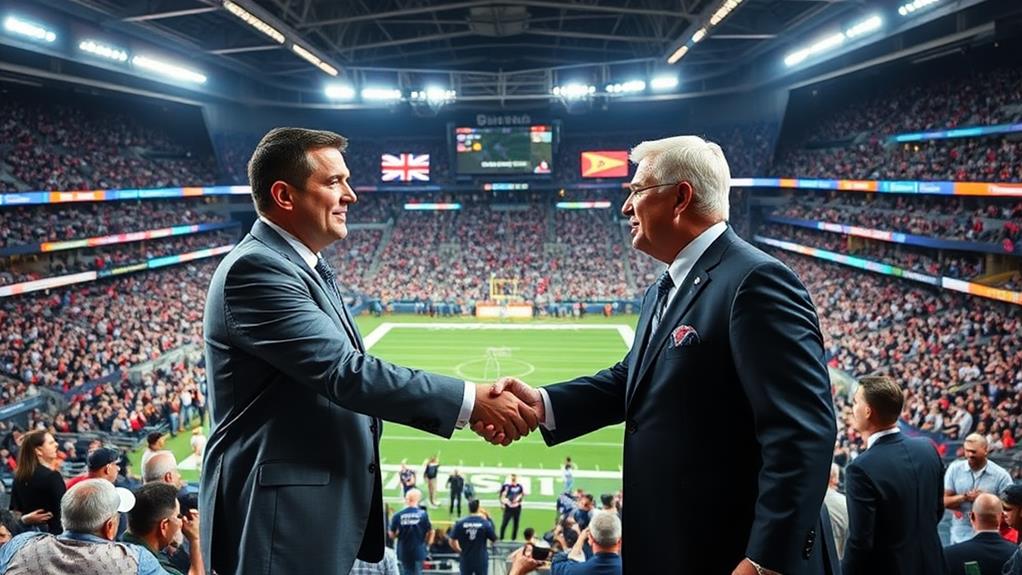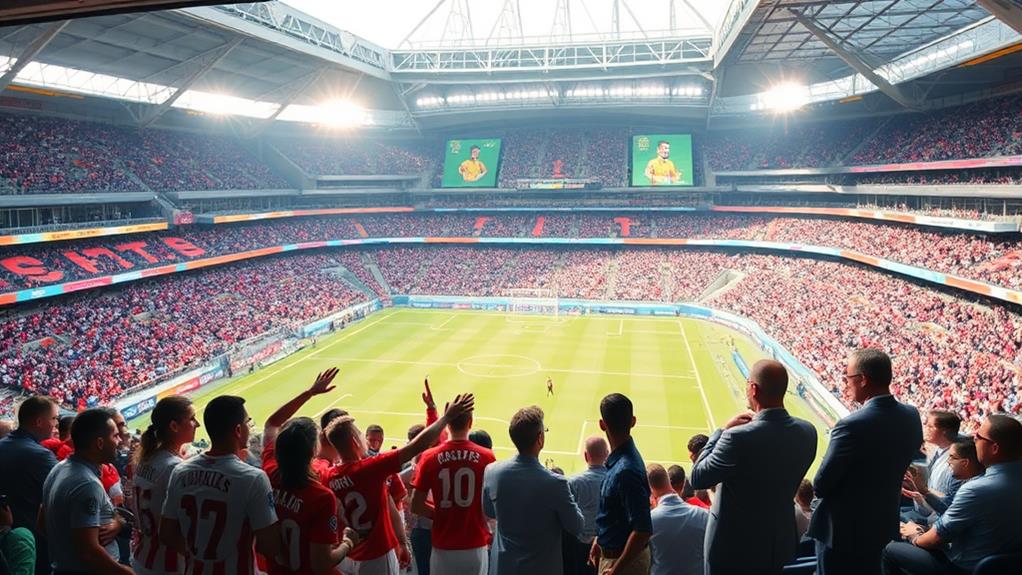Sports and corporate sponsorships form a powerful partnership that benefits both parties. This partnership offers immense brand visibility and emotional connections with loyal fans, leading to increased sales and customer loyalty.
In fact, 71% of fans recommend brands sponsoring their teams, making sponsorships a valuable investment.
Effective sponsorships also offer networking opportunities that can lead to new business relationships and collaborations. Moreover, sponsorship success can be measured through Key Performance Indicators (KPIs), allowing companies to evaluate their return on investment.
By aligning your brand with community initiatives, you can enhance public perception and foster goodwill. For example, sponsoring local charity events or youth sports programs can create a positive association with your brand.
By doing so, you can maximize this mutually beneficial relationship and reap the rewards of sports and corporate sponsorships.
Overview of Sports Sponsorship

Sports Sponsorship: A Strategic Avenue for Brand Visibility
Companies invest in sports sponsorship to gain brand visibility and marketing leverage. This financial backing supports the operational needs of teams, enhances their performance, and increases fan engagement. In the United States, companies spend approximately $16.4 billion on sports sponsorships annually, recognizing the immense potential for brand exposure.
Sports sponsorship creates a genuine emotional connection between fans and their favorite teams. This connection fosters brand loyalty, driving increased sales and brand awareness for sponsors. Effective sponsorships go beyond mere logo placements, often including community engagement initiatives that resonate with fans' values and interests, amplifying the partnership's impact.
For instance, a sports drink brand might partner with a marathon event to provide hydration stations, engaging with runners and spectators alike.
Measurable outcomes are essential in evaluating the success of sports sponsorships. By tracking key performance indicators (KPIs) like media coverage and social media engagement, businesses can quantify the return on investment (ROI) and determine how well their sponsorship aligns with their marketing objectives.
This data-driven approach enables companies to refine their sponsorship strategies and optimize their ROI.
Sports sponsorship emerges as a strategic avenue for businesses seeking to elevate their brand presence and community connection. By leveraging the emotional connection between fans and teams, companies can foster brand loyalty, increase brand awareness, and drive sales.
Key Benefits for Companies
Investing in sports sponsorship offers companies a multitude of key benefits. By partnering with popular sports teams, companies can tap into the approximately $16.4 billion spent annually on sponsorships, gaining substantial brand visibility through events and media coverage. This exposure enhances their corporate image and reputation, allowing them to connect with target audiences effectively.
Sports sponsorship fosters emotional connections between fans and brands. When fans feel a bond with a company, they're more likely to exhibit customer loyalty and increased sales, translating into a strong competitive edge. For instance, a survey by the Sports & Fitness Industry Association found that 71% of fans are more likely to recommend a brand that sponsors their favorite team.
Sponsorship deals present invaluable networking opportunities. Companies can connect with other business leaders and potential partners at sporting events, facilitating connections that can drive business growth and collaboration. For example, a company might meet a potential supplier or client at a VIP event hosted by the sponsored team.
Companies can track measurable returns on investment. By monitoring metrics like social media engagement and increased sales, companies can optimize their sponsorship strategies, ensuring that their investment yields the best possible results. This data-driven approach helps companies refine their sponsorship efforts and maximize their ROI.
Sports sponsorship is a strategic partnership that elevates brand presence and profitability. By leveraging the benefits of sports sponsorship, companies can increase brand visibility, foster emotional connections, and drive business growth, ultimately leading to a significant increase in brand presence and profitability.
Types of Sponsorship Arrangements

Sponsorship arrangements can significantly impact both brands and sports teams. One common form is financial support, where corporations provide essential funds for operations, travel, and talent acquisition. For instance, the global sports sponsorship market is valued at approximately $16.4 billion annually, making these arrangements crucial for sustaining athletic programs.
In-kind sponsorship opportunities allow companies to exchange products or services instead of cash. This can include providing equipment, training materials, or promotional resources, enhancing a team's operations without direct financial transactions. For example, a sports drink company might provide its products to a team instead of giving them money.
Strategic partnerships focus on mutual growth through community projects, sustainability initiatives, and promoting diversity and inclusion in sports. These arrangements create a platform for brands to showcase their commitment to social responsibility while gaining valuable brand exposure through team-related events and advertising.
For instance, a brand might partner with a team to develop a youth sports program, promoting both the brand's values and the team's community engagement.
The right sponsorship arrangements create a mutually beneficial relationship, allowing both parties to thrive while maximizing their resources and reach. By understanding these types of sponsorships, brands can strategically position themselves to take full advantage of the opportunities available in the world of sports.
Negotiating Sponsorship Deals
Timing is Crucial in Sponsorship Negotiations
Timing plays a significant role in negotiating sponsorship deals. Aligning discussions with key events or seasons can amplify interest and engagement. For instance, approaching a sports brand during a major tournament or a holiday season can increase the likelihood of a successful partnership.
Focus on Brands that Align with Your Values
To maximize your chances of success, focus on brands that resonate with your values and target demographics. Understanding a brand's goals, such as boosting brand visibility or connecting with specific audiences, enables you to craft tailored proposals that meet both parties' needs. For example, if your organization promotes environmental sustainability, partnering with a brand that shares the same values can lead to a more effective collaboration.
| Key Considerations | Action Steps |
|---|---|
| Identify Brand Fit | Research brand values and target demographics. |
| Clarify Contract Terms | Outline payment structures and obligations clearly. |
| Leverage Market Insights | Use data to showcase fair value and ROI potential. |
Flexibility is Key in Negotiations
Flexibility in negotiations is essential; be willing to adapt terms to create mutually beneficial agreements. Thorough market research will provide you with leverage, ensuring that you can present compelling evidence during discussions. This enables you to negotiate fair terms that benefit both parties.
Clear Contract Terms Prevent Misunderstandings
Achieving contract clarity is crucial; ensure all terms are explicitly defined to prevent misunderstandings and foster a smooth partnership. By doing so, you can avoid potential disputes and ensure a successful collaboration. By employing these strategies, you'll position yourself for successful sponsorship negotiations that benefit everyone involved.
Impact on Sports Organizations

Sponsorship deals provide significant financial and strategic benefits to sports organizations.
Sponsorship deals bring in substantial financial resources, with approximately $16.4 billion spent annually on sports sponsorships. This financial backing enables sports teams to invest in talent and enhance facilities, ultimately improving their competitive edge.
For example, a team can use sponsorship funds to build a state-of-the-art training facility, attracting top players and improving their performance.
Sponsorship deals increase brand visibility and fan engagement.
Major global events draw millions of viewers, creating vast exposure opportunities for both sponsors and sports organizations. When fans develop an emotional connection with sponsoring brands, it fosters customer loyalty, leading to increased ticket sales and merchandise revenue.
For instance, a sports team partnering with a popular apparel brand can increase merchandise sales and create a loyal fan base.
Successful sponsorship arrangements improve public perception and community engagement.
Strategic partnerships can significantly boost a team's image within the community. For example, a healthcare sponsor promoting health initiatives alongside team support can enhance a team's reputation and build trust with fans.
Additionally, sponsorship deals can provide in-kind support, such as equipment and services, enhancing operational capabilities and event quality.
Evolving Trends in Sponsorship
The sports sponsorship landscape has undergone a significant transformation in recent years, shifting from basic logo placements to dynamic, digital partnerships that deeply engage fans.
Evolving Trends in Sports Sponsorships
The focus of sports sponsorships has shifted to prioritize fan engagement, social responsibility, and technology integration.
Sustainability Focus
Brands are now aligning themselves with community initiatives, reflecting consumer expectations for socially responsible practices.
For instance, companies like Patagonia and Reebok have made commitments to reduce their environmental impact, resonating with consumers who value eco-friendliness.
Naming Rights Expansion
High-profile deals, such as stadium naming rights, demonstrate the growing investment in sports marketing and the potential for increased visibility.
The Los Angeles Lakers' stadium, for example, is named the Crypto.com Arena, highlighting the lucrative nature of such partnerships.
Technology Partnerships
Collaborations between sports teams and technology companies, like AWS and F1 teams, showcase how technology can enhance team performance and enrich fan experiences.
AWS's partnership with the Formula 1 team, for instance, provides data analytics to improve racing strategies and enhance fan engagement through real-time statistics and insights.
Measuring Sponsorship Success

Measuring Sponsorship Success
To effectively evaluate the impact of your sponsorship investment, it is crucial to track key performance indicators (KPIs) that reveal the partnership's effectiveness.
Critical KPIs for Sponsorship Measurement
Four essential KPIs to measure sponsorship success are:
| KPI | Measurement Method |
|---|---|
| Brand Exposure | Cost per Thousand Impressions (CPM) |
| Audience Engagement | Cost per Click (CPC) |
| Return on Investment | Sales Data Analysis |
| Social Media Engagement | Engagement Rate (Likes, Shares, Comments) |
Understanding Return on Investment (ROI)
By adopting a data-driven approach, you can gain valuable insights into your ROI. Continuously tracking sales before, during, and after sponsorship activation can highlight the impact on revenue and consumer behavior. Benchmarking against industry standards provides context to your findings.
Transparency in Reporting
Transparency in reporting sponsorship outcomes fosters trust between you and the sports entities involved, ensuring better collaboration and improvement in future engagements. Measuring sponsorship success isn't just about numbers; it's about leveraging insights to maximize the effectiveness of your partnerships.
Case Studies of Successful Partnerships
Successful Sports Sponsorships Drive Brand Visibility and Engagement
Strategic partnerships in sports sponsorship can significantly enhance brand visibility and consumer engagement.
Coca-Cola's 90-year partnership with FIFA World Cup is a prime example, allowing the brand to connect with millions of people worldwide and increase brand exposure.
Another successful partnership is Advent Health's sponsorship of various professional and collegiate teams.
By tapping into the popularity of sports, Advent Health promotes its health initiatives to a broader target audience.
Allianz Stadium's naming rights associate the brand with a top football club, providing extensive visibility through match-day events and media coverage.
These successful sports sponsorships demonstrate how brands can harness the power of sports to engage with passionate fan bases, boosting exposure and connecting meaningfully with their target audience.
Questions and Answers
What Is the Difference Between Corporate Partnership and Sponsorship?
Corporate partnerships and sponsorships differ in their focus and dynamics.
Sponsorships primarily focus on financial support and brand visibility. For instance, a company might sponsor an event in exchange for brand promotion and advertising opportunities.
In contrast, corporate partnerships emphasize deeper collaboration and strategic alignment between the partners.
Partnerships require more complex contract negotiations.
Unlike sponsorships, partnerships involve shared resources, mutual goals, and ethical considerations. For example, a partnership between a tech company and a non-profit organization might involve joint research projects, shared funding, and collaborative marketing efforts.
Audience engagement is typically richer in partnerships.
Partnerships are built on mutual goals, leading to more meaningful interactions with the target audience.
In contrast, sponsorships often focus on promotional activities, which may not lead to the same level of engagement. For instance, a partnership between a sports team and a health food brand might involve joint community outreach programs, resulting in more authentic connections with the audience.
Are Sponsorships Considered Partnerships?
Sponsorships are a type of partnership. This is because they involve two parties working together to achieve mutual benefits. In a sponsorship, a brand partners with an event, team, or individual to increase brand awareness and reach a target audience.
The brand provides financial support, and in return, the event, team, or individual promotes the brand through various means, such as logo placement or public appearances.
Effective sponsorships require alignment of branding strategies. For example, a sports brand might partner with a professional athlete who embodies the brand's values and target audience.
The athlete's endorsement increases the brand's credibility and reach, while the brand provides the athlete with financial support and resources.
To ensure the partnership is successful, both parties must consider the financial implications and community engagement aspects. This includes discussing and agreeing upon the terms of the sponsorship, including the amount of financial support and the expected promotional activities.
Trust and effective communication are crucial to navigating any challenges that may arise and achieving mutual goals.
How Has Sports Been Influenced by Corporate Sponsorships?
Corporate sponsorships have significantly impacted sports by increasing brand visibility and driving event marketing strategies.
For instance, athlete endorsements have proven to elevate both the sport and the brand, fostering deeper consumer engagement. Nike's partnership with Colin Kaepernick is a prime example, where the brand's sales and brand image both benefited from the collaboration.
Effective sponsorship activation amplifies a company's social responsibility and community outreach efforts, creating a positive image.
The NBA's partnership with Kaiser Permanente is a great illustration of this, where the two entities worked together to promote health and wellness in local communities.
This synergy not only boosts performance and fan loyalty but also positions sports as a powerful platform for brands to connect with audiences on a personal level.
The FIFA World Cup's partnership with Coca-Cola is a testament to this, where the brand's activation campaigns have become an integral part of the tournament's experience.
What Benefits Do Corporations Receive From Sponsorships?
Corporations receive several benefits from sponsorships.
Investing in sponsorships increases brand visibility, allowing companies to reach a wider audience and enhance consumer engagement.
Targeted marketing enables companies to reach specific demographics, which fosters brand loyalty and community outreach. For instance, a company targeting young adults may sponsor music festivals or extreme sports events.
Event activation showcases a company's commitment to social responsibility, aligning the brand with positive values that resonate with consumers.
By sponsoring events or causes, companies demonstrate their values and ethics, which can lead to a positive brand image. For example, a company sponsoring a charity marathon demonstrates its commitment to health and wellness.
Strategic partnerships create lasting connections that drive sales and deepen customer relationships.
By partnering with events or organizations, companies can build trust with their target audience, leading to increased sales and customer loyalty.
Ultimately, sponsorships can elevate a company's corporate image and lead to long-term business success.